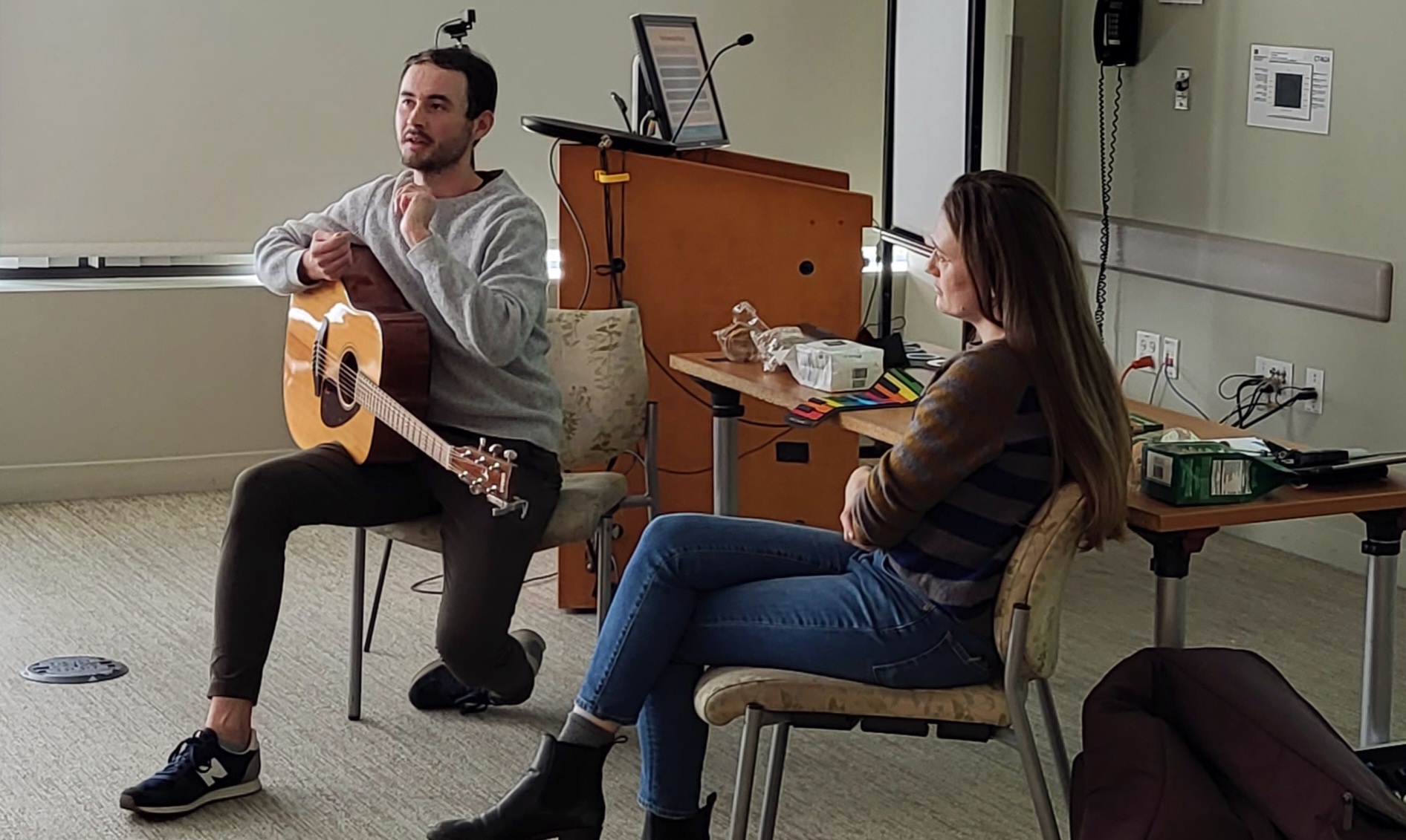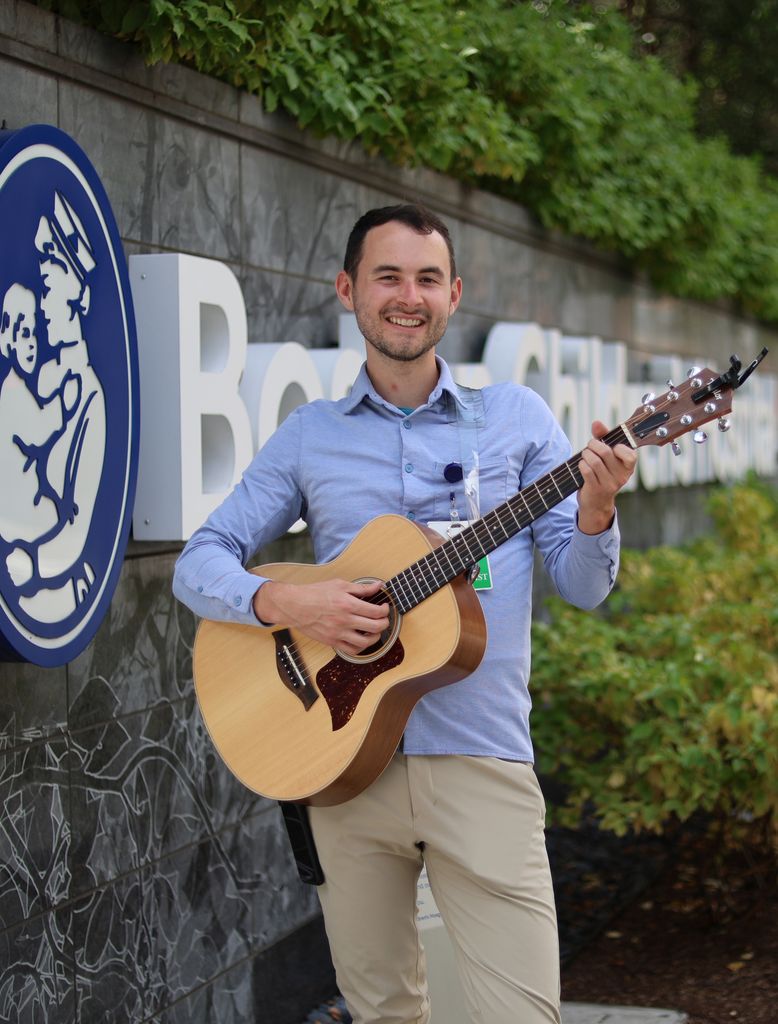Alum Creates Music as a Healing Tool for Young Patients.

Mark Fuller, Jr., SPH alum and music therapist at Boston Children’s Hospital, performs with his BCH colleague and music therapist Alex Ford during a visit to SPH’s Trauma, Trauma-Informed Care, Recovery & Resilience class last semester. Photo by Carol Dolan.
Alum Creates Music as a Healing Tool for Young Patients
As a music therapist at Boston Children’s Hospital, Mark Fuller, Jr. uses evidence-based music strategies to provide comfort and instill resilience among sick children and their families as they navigate difficult hospital care.
Being admitted to the hospital can be a stressful or frightening experience for people of any age, but the constant activity and unfamiliar sounds in medical settings can be especially traumatic for children who are dealing with severe illnesses. A School of Public Health alum is part of a team of music therapists at Boston Children’s Hospital (BCH) that helps allay this trauma by using music to provide support and healing comfort to children and young adults during their time at the hospital.

Mark Fuller, Jr. (SPH’22) works closely with acute and intensive-care cardiology patients at BCH as young as infants to 25 years old, and their families, as they navigate what can be a scary or distressing experience in the emergency room or as an admitted patient.
The leading pediatric hospital’s Music Therapy program represents a growing area of evidence-based clinical treatment that uses music as a tool to improve both physical and psychological health. Several studies have shown that music can have a profound healing effect on the body and the mind. The music therapy sessions led by the board-certified music therapists with their patients provide wide-ranging benefits, such as reducing pain and anxiety, improving motor skills, speech and language development, enhancing self-esteem, encouraging self-expression, and providing a comforting distraction when it’s needed the most.
“The intensive care unit is a sterile environment, and there are a lot of unfamiliar noises and sounds that are somewhat stressful for our families,” says Fuller, a Berklee College of Music-trained music therapist who completed the CAPDIE certificate last year at SPH while working full-time at BCH. “I try to come into the intensive care unit and find moments where families can connect as a family unit through music—whether that’s bonding over a song they all enjoy, or recording a lullaby to have available when their child goes to the operating room.”
Part of what makes this unique therapy so effective is the individualized approach that music therapists take with the patients. Each child gets immersed in music-based activities tailored to their age, interests, experiences, and physical, mental, and emotional needs. Fuller engages with patients in all phases of their treatment, communicating first with the children and their caregivers, and with an interdisciplinary team of doctors and nurses, physical and occupational therapists, social workers, child life specialists, psychologists, and speech language pathologists to understand the child’s full treatment plan, recovery goals, stresses or struggles, and life outside of the hospital—details that he uses to determine how music can become an integral component to their healing process.
“I work with the families to understand more about their daily experiences at the hospital, what they perceive as stressful and difficult moments, and how I can be there for them to create music-based strategies that support their clinical and psychological outcomes,” says Fuller, who sings and plays several instruments, including the guitar and piano. “I’ll ask which songs they listen to, which artists are familiar to them, what style of music that they enjoy, and also how they access the music—that’s a really important factor, especially from a public health perspective. I’m not going home with the patients, so I need to figure out strategies that can be carried over from the hospital experience and into their home and their community.”
Many BCH pediatric patients in the cardiac unit face a range of physical and mental health complications, and comorbidities are common. “I might have a child who has pulmonary stenosis or congenital heart disease, and is simultaneously experiencing anxiety, depression, or suicidal ideation,” Fuller says. “All of that is taken into consideration to help identify the best path forward in our treatment plan.”
He uses live music on voice and guitar for procedural support at the patients’ bedside while they receive a blood draw, echocardiogram, or dressing change. The lyrics may reflect their favorite song, or they may be more educational in nature, explaining each step of the procedure to help them relax, be aware of what’s happening around them, and build trust with their care team. This approach is informed by the Gate Control Theory of Pain, a concept coined by Ronald Melzack and Patrick Wall in 1965 that states that spinal nerves act as “gates” that can control how pain messages travel to the brain, thus suggesting that our mental state affects our perception of pain and can increase or reduce pain sensations.
Music intrinsically really embodies the core values of trauma-informed care.
Fuller recalls one instance in which he created a song during daily dressing changes for a child who had a Berlin Heart, a heart pump that maintains blood flow in young children with severe heart failure. It’s important that children lay still during this procedure—understandably difficult for toddlers. To make the child feel more comfortable and engaged in their care, we created a song that “reimagined the child as a superhero to praise them for their strength and resiliency,” he says.
“We took that concept and created a song using the child’s name and gave them a superhero name, creating an imaginative world that walked them through all of the different steps of the procedure in a playful way,” he says. “The bandages placed on the child became pillows or clouds that the child is laying on in the sky. A sterile soap that they have to scrub on their chest was reimagined as pink bubbles. We transformed the environment through the music and the lyrics so that the child was included in their medical care in a way that gives them a voice and autonomy in a space that can be seen as scary, sterile, and somewhat painful.”
Fuller also supports grieving families who are losing their child at the hospital. When a patient passes away, the music therapists can develop a heartbeat “legacy project” that records the child’s heartbeat, placing it over a meaningful song the family identifies.
“We pair the beats per minute of that heart rate and match it to the song that is selected so that the beat of the heart becomes the foundation of the song that’s memorable to the family,” says Fuller. “It’s a really unique and individualized way of creating something that can stay with the family once the child passes and celebrate everything that the child is to their loved ones.”
Last semester, Fuller returned to SPH with his BCH colleague Alex Ford to engage in discussion with students about music therapy in pediatric settings in the course Trauma, Trauma-Informed Care, Recovery & Resilience, taught by Carol Dolan, clinical associate professor of community health sciences. He took this course as a student and says it helped him understand how to develop trauma-informed and resilience-building programs and interventions that can support interpersonal- and disaster-based trauma across the lifespan.
“This course helped deepen my understanding of the complexity of trauma across the lifespan and how to be a trauma-informed provider,” Fuller says. ”Music intrinsically really embodies the core values of trauma-informed care by creating a safe space for musical expression, collaboration, choice, trust, and empowerment, to promote resiliency as a patient and family navigate their health experience.”